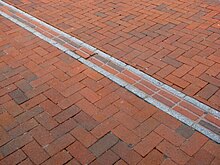| Freedom Trail | |
|---|---|
 Special markers implanted in the sidewalk denote the stops along the Freedom Trail | |
| Length | 2.5 mi (4.0 km) |
| Location | Boston, Massachusetts |
| Established | 1951 |
| Designation | National Millennium Trail |
| Trailheads | Boston Common to Bunker Hill Monument in Charlestown |
| Use | Walking, History |
| Difficulty | Easy |
| Sights | 17 historical sites |
| Surface | Brick |
| Website | www |


The Freedom Trail is a 2.5-mile-long (4.0 km) path[1] through Boston that passes by 16 locations significant to the history of the United States. It winds from Boston Common in downtown Boston, to the Old North Church in the North End and the Bunker Hill Monument in Charlestown. Stops along the trail include simple explanatory ground markers, graveyards, notable churches and buildings, and a historic naval frigate. Most of the sites are free or suggest donations, although the Old South Meeting House, the Old State House, and the Paul Revere House charge admission. The Freedom Trail is overseen by the City of Boston's Freedom Trail Commission[2] and is supported in part by grants from various non-profit organizations and foundations, private philanthropy, and Boston National Historical Park.
The Freedom Trail was conceived by journalist William Schofield in 1951, who suggested building a pedestrian trail to link important landmarks. Boston mayor John Hynes decided to put Schofield's idea into action. By 1953, 40,000 people were walking the trail annually.[3]
The National Park Service operates a visitor center on the first floor of Faneuil Hall, where they offer tours, provide free maps of the Freedom Trail and other historic sites, and sell books about Boston and United States history.
Some observers have noted the tendency of the Freedom Trail's narrative frame to omit certain historical locations, such as the sites of the Boston Tea Party and the Liberty Tree.[4]
- ^ "Black Heritage/Freedom trail". Google My Maps. Retrieved October 13, 2021.
- ^ "Freedom Trail". City of Boston. Retrieved November 1, 2013.
- ^ O'Connor, Thomas H. (1993), Building a new Boston: politics and urban renewal, 1950–1970, Boston: Northeastern University Press, ISBN 978-1-55553-161-4, ISBN 155553161X
- ^ Alfred F. Young (March 21, 2004), "The Trouble with the Freedom Trail", Boston Globe